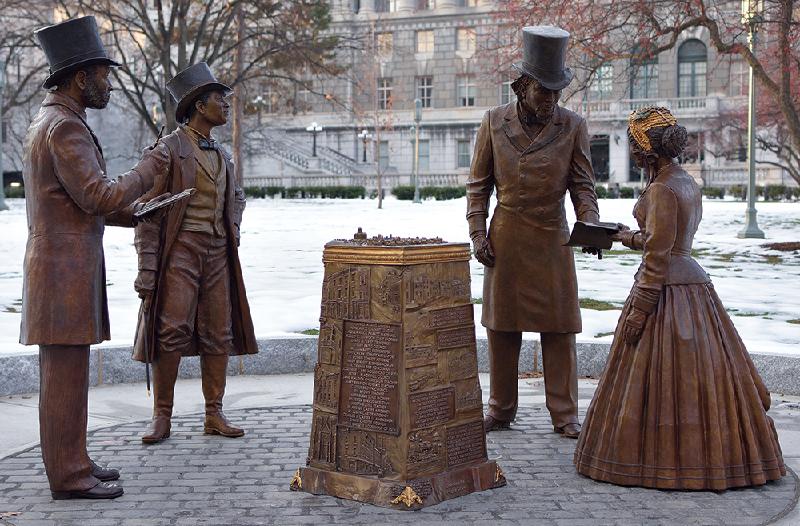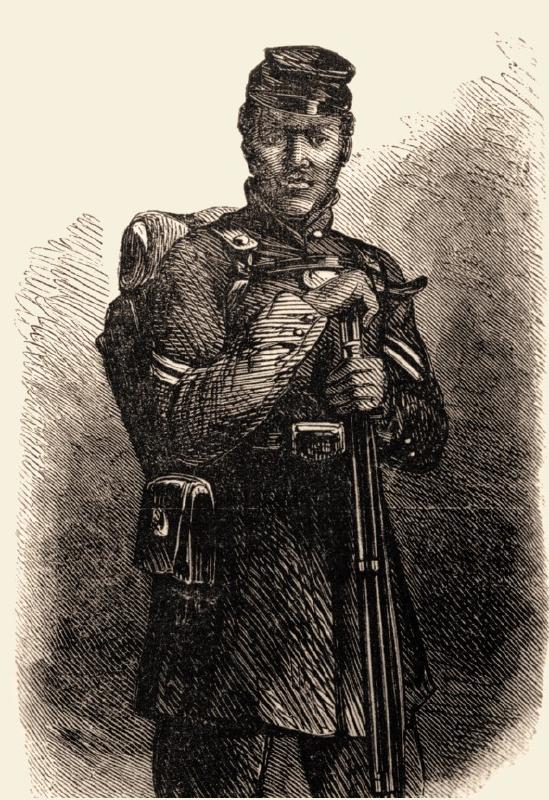
In 2020, as communities around the nation took down old monuments symbolizing the legacies of American slavery, Harrisburg residents set up a monument to African American history and the power of the vote.
On August 26, 2020, A Gathering at the Crossroads commemorated the anniversaries of the fifteenth and nineteenth amendments through the installation of a monument to Harrisburg’s Black history. One hundred and fifty years after the right to universal male suffrage was granted to the people of the United States, and one hundred years after the right for women’s suffrage, 2020 marked the intersection of the legacies of past achievements, and the inconsistencies and obstacles of the present. Beginning in the Spring of 2020, protests against police brutality toward Black Americans swept the nation, calling attention to continued injustices in American society.
At the height of this racial reckoning, a bronze monument was placed at the Irvis Equality Circle in front of Harrisburg’s capitol complex. A little over a century ago, neither the Circle nor the expansive capitol building existed. The area where this monument now stands was in a part of the Old Eighth Ward known as Tanner’s Alley, a predominantly African American neighborhood. Instead of lush green spaces and domed ceilings, this part of Harrisburg was filled with thriving churches, schools, businesses, and private residences. In the early twentieth century, however, these spaces were torn down and families were forced out of their homes due to the capitol expansion project. The City Beautiful movement started as a push to create new green spaces and waste disposal measures that would benefit the entire community, but by the 1910s, it had morphed into a drive to complete the capitol complex which stands today. The residents of the Old Eighth were required to relocate, and for many years, their names and stories were neglected.
The monument at Irvis Equality Circle is, to this day, the only monument on capitol grounds constructed to honor its Black community. Titled A Gathering at the Crossroads, the monument marks a joint effort by the International Institute for Peace through Tourism to bring recognition to Harrisburg’s long-neglected Black history. The Commonwealth Monument Project was led by Lenwood Sloan (Executive Director), Jeb Stuart (Secretary Logistics and Installation), Kelly Summerford (Treasurer), Phyllis Bennett (Government and Business Liaison), and Valerie Leblanc (Planning and Development). It enjoyed bipartisan support from both the Pennsylvania House of Representatives and Senate, along with major financial contributions from the City of Harrisburg, the Foundation for Enhancing Communities, Peggy Grove, Dauphin County Commissioners, Messiah University, Senator Sharif Street, and many other generous individuals and organizations.
Artist Becky Ault and Art Design Group have crafted four life-sized statues of African American orators, each of whom made major contributions in the quest for racial justice in America and have a meaningful connection to the city of Harrisburg.
The first, Reverend William Howard Day, was an orator and one of America’s most renowned civil rights activists of his time. His contributions to Harrisburg were plentiful. In the 1870s, Day was appointed to the Harrisburg School Board of Directors. He successfully led the Board in allocating funds to public schools for new textbooks and blackboards. Day fought for better education for African Americans both by improving the schools that existed for African American students and by beginning the process of integration at Harrisburg’s all-white Boys High School. Day was also an active community leader at the Wesley Union AME Zion Church on South Street.
To Day’s left stands Francis Harper, who fought for the abolition of slavery, women’s right to vote, and temperance. This statue of Francis holds the Fifteenth Amendment, which guaranteed universal male suffrage. Passing it back to Day, this representation of Harper reflects that there was still more to do; women were not yet enfranchised. The historical Harper was a renowned antislavery journalist, poet, and public speaker, who gave lectures in cities across the United States, including Harrisburg. One of her most famous speeches, “We Are All Bound Up Together,” expressed the frustrations of Black women being largely excluded from the women’s suffrage movement, and urging the application of female suffrage to all women.
The next figure represented is Jacob T. Compton, sergeant in Company D of the 24th United States Colored Infantry (USCT) and local musician. In the Harrisburg community, Compton was known for leading the choirs of both AME and AME Zion churches, and for founding the Excelsior Band. Compton was also a carriage driver. Among the ranks of his passengers was Abraham Lincoln, soon to be the sixteenth president of the United States. In February 1861, before his inauguration, president-elect Abraham Lincoln visited Harrisburg. After an assassination plot was uncovered, Lincoln was quickly whisked away to Philadelphia. It was Compton who made the president-elect’s escape possible by driving this carriage.
The final statue portrays T. Morris Chester, a Civil War correspondent and Harrisburg native. In 1863, he became the Captain of one of Harrisburg’s Union companies. Through 1864, Chester reported on the war effort, particularly the contributions of African American troops. Most newspapers completely overlooked the African American soldiers, but through Chester’s journalism, papers such as the Philadelphia Press printed information about them. After the war, Chester returned to Harrisburg where he became the secretary of the Garnet Equal Rights League and advocated for Black citizenship.
These four visionaries surround a pedestal at the center of the monument. A model of the Old Eighth Ward sits on top. This neighborhood was home to a thriving community with significant Black, Jewish, and immigrant populations. A blue star indicates the location of the monument relative to the vanished landscape of the Old Eighth Ward. The sides of the pedestal bear the names of one hundred influential Black residents of Harrisburg. These individuals were freedom seekers, abolitionists, suffragists, church leaders, doctors, businesspeople, poets, and more. All called Harrisburg home, and all fought for a better, more equitable city.
The impact of the many Black Americans honored by A Gathering at the Crossroads is not confined to this space on Walnut Street. Their legacies are everywhere, in Harrisburg’s school system, churches, cemeteries, and homes. We invite you to explore their stories through the “Chester Way” tour. Each location highlights a moment in time when Harrisburg’s residents spoke out against oppressive structures and ushered in radical change in areas of education, politics, and social life. As you explore each stop on the tour, you may discover something new about the capital city’s history and find yourself at a different kind of “crossroads,” as the struggles, hopes, and triumphs of the past meet the projects of the present.
A full list of the resources used in this story can be found here.
Video
Images





